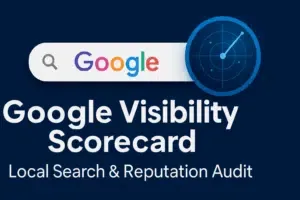Introduction to AEO and GEO
The search landscape is undergoing its biggest transformation since Google launched. Traditional SEO isn’t going away, but Answer Engine Optimization (AEO) and Generative Engine Optimization (GEO) are now critical for brands that want to stay visible.
Search is no longer about ranking for “10 blue links.” Instead, AI-powered tools like Google AI Overviews, Bing Chat, Perplexity AI, and ChatGPT Web, are delivering direct answers and synthesized overviews — often without requiring users to click a website.
If you want your brand to be the answer in this AI-first search era, it’s time to understand and apply both AEO and GEO.
Just like the Four Pillars of SEO, AEO and GEO build on the same foundations of technical, on-page, and off-page optimization—then adapt those fundamentals for AI answers and generative citations.
AEO vs GEO Comparison
The Evolution of Search
From Search Engines to Answer Engines
In the past, Google served results and let users decide where to click. Today, “answer engines” surface one authoritative response, often pulling from multiple sources. This shift means visibility depends on your content being selected by AI — not just ranked by an algorithm.
From Keywords to Conversations
Modern users speak to search engines like people:
- “What’s the best roofing material for humid climates?”
- “How do I fix my leaking sink without replacing it?”
Optimizing for natural language and intent is now essential.

What is Answer Engine Optimization (AEO)?
Definition:
AEO is the practice of structuring your content so AI-powered answer engines can identify and use it as a direct, trusted answer.
How It Works:
- Schema Markup: Adding structured data to help AI understand context.
- Featured Snippet Optimization: Providing short, clear answers high in the content.
- Question-Based Formatting: Using H2/H3 headers that match common queries.
Key Tactics:
- Build FAQ sections with proper schema markup.
- Write short, factual answers before diving into details.
- Keep data updated and cite credible sources.
Benefits:
- Higher chance of being read aloud by voice assistants.
- Featured in Google’s People Also Ask and other AI answer boxes.
What is Generative Engine Optimization (GEO)?
Definition:
GEO focuses on optimizing for AI-powered generative search tools that rewrite, synthesize, and blend answers — citing sources selectively.
How It Works:
- AI crawlers ingest and reinterpret your content.
- Engines like Google SGE and Perplexity AI aim to provide a comprehensive overview, often citing a few trusted sources.
Key Tactics:
- Publish original insights, proprietary data, and expert commentary.
- Strengthen E-E-A-T (Experience, Expertise, Authoritativeness, Trustworthiness).
- Write in AI-friendly formats: clean structure, context-rich sentences, relevant subheadings.
Benefits:
- Inclusion in AI-generated overviews with brand attribution.
- Long-term authority in emerging AI-driven search platforms.
How do SEO, AEO, and GEO work together?
SEO builds the foundation—fast, crawlable pages with strong keywords and links so you can rank in search results. AEO shapes content into clear, question-and-answer formats that appear in featured snippets, voice search, and AI answers. GEO goes further by making your content credible and structured enough to be cited by generative AI tools like ChatGPT or Google’s AI Overviews.
To succeed here, it helps to explore how AI content creation is shaping modern strategies, since the quality and structure of your writing directly impact whether AI systems use you as a source.
Together, SEO, AEO, and GEO ensure your brand is visible in SERPs, discoverable in AI answers, and referenced in generative responses—multiplying trust, authority, and reach.
AEO vs. GEO: Key Differences
Feature
- Goal
- Content Style
- Technical Focus
- Main Platforms
AEO
- Direct answers in AI/voice search
- Short, concise, structured
- Schema markup, Q&A format
- Google PAA, voice assistants
GEO
- Being cited in AI-synthesized overviews
- In-depth, insight-driven
- Brand authority, unique data
- Google SGE, Perplexity, ChatGPT
How to Prepare for Both AEO & GEO
- Implement Structured Data Markup (FAQ, HowTo, LocalBusiness).
- Answer First, Explain Second — short answer, then detailed breakdown.
- Build Topical Authority with pillar content and internal links.
- Publish Unique Value — surveys, studies, original graphics.
- Maintain Technical SEO — site speed, mobile performance, accessibility.
Common Mistakes to Avoid
- Keyword stuffing without intent alignment.
- Skipping schema markup entirely.
- Using AI tools for generic content with no unique insights.
- Ignoring site performance and UX.
The Future of Search
As AI becomes the primary way users interact with search, brand trust will outweigh keyword ranking. The most successful websites will:
- Build an omnichannel presence (video, audio, written).
- Become the go-to source for niche expertise.
- Adapt faster than competitors to AI search shifts.
Conclusion - AEO and GEO aren’t replacing SEO
AEO and GEO aren’t replacing SEO — they’re layering on top of it. Businesses that adapt now will secure prime visibility in the AI-first search landscape.
If you want your content to be the answer users see — and the source AI cites — it’s time to optimize for both AEO and GEO.
Ready to future-proof your SEO? Contact us to create an AI-optimized strategy that works for today’s and tomorrow’s search engines.
Frequently Asked Questions about: AEO vs. GEO
AEO is optimizing content so AI/answer engines (e.g., voice assistants, PAA, AI Overviews) can lift your text as a direct, short answer.
GEO is optimizing to be cited by generative search (e.g., Google SGE-style overviews, Perplexity, ChatGPT Search) that synthesize multiple sources.
Yes. Technical SEO, crawlability, speed, and intent-focused keywords remain the foundation that AEO and GEO build on.
AEO favors crisp, structured, Q&A style answers. GEO favors depth: original insights, context, and expert perspective that algorithms can summarize and cite.
Clear headings that match questions, concise first-paragraph answers, bulleted steps, definitions, and on-page FAQs.
E-E-A-T (experience, expertise, authoritativeness, trust), original data, author bios, citations, and brand mentions across the web.
For most sites: FAQPage, HowTo, Product/Offer, Article, and LocalBusiness. (Schema supports both AEO visibility and GEO understanding.)
Publish unique research, comparisons, calculators, or frameworks; earn reputable backlinks; get quoted by industry publications; keep pages fresh.
Track impressions in answer boxes/AI overviews (when available), branded mentions, assisted conversions, long-tail query traffic, and engagement on pillar pages.
Lorem ipsum dolor sit amet, consectetur adipiscing elit. Ut elit tellus, luctus nec ullamcorper mattis, pulvinar dapibus leo.

Michael Klasno is SERP Sniper – Building local optimized websites for Attorneys, Law Firms and Business Professionals in Houston and Southeast Texas.
Michael Klasno is a consummate Search Engine Optimization (SEO) Specialist with an impressive 20-year tenure in the digital marketing landscape. Throughout two decades, Michael has been at the forefront of evolving website design & SEO strategies, seamlessly integrating the latest trends with time-tested methodologies.
His SEO expertise encompasses a vast array of skills, including keyword research, technical SEO, (both on-page and off-page) Local SEO, Google Business Profile optimization, SEO auditing, competitive analysis, and content strategy formulation.
“By building a cost effective corporate or business website that looks great and has a high conversion rate you can dominate the organic search results.”



